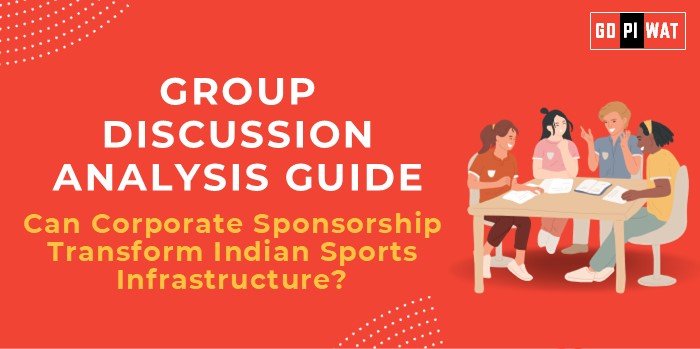📋 Group Discussion Analysis Guide
🏅 Can Corporate Sponsorship Transform Indian Sports Infrastructure?
🌟 Introduction to the Topic
- 📜 Opening Context: Indian sports have long faced infrastructure challenges, from outdated facilities to limited access. The influx of corporate sponsorship has the potential to bridge these gaps, creating a world-class sporting environment.
- 📖 Background: Corporate involvement in sports gained momentum with the 1983 Cricket World Cup win, but its role has expanded significantly in recent years with leagues like the IPL and ISL driving private investments into sports. The question remains whether this momentum can transform the broader infrastructure.
📊 Quick Facts and Key Statistics
- 💰 Sports Sponsorship Market: Valued at ₹9,500 crore in 2023, with a 20% annual growth.
- 🏏 Cricket Dominance: Receives 65% of sponsorship funds.
- 🎯 Other Sports Growth: Kabaddi (Pro Kabaddi League) grew its sponsorship value by 25% in 2023.
- 🥇 Olympic Medal Count (India, 2020): 7 medals—India ranks 48th globally.
- 🏟️ Stadium Accessibility: Only 30% of Indian districts have modern sports facilities.
🤝 Stakeholders and Their Roles
- 🏢 Corporates: Provide funding, sponsor leagues, and promote talent. Examples: Reliance in football and Tata in archery.
- 🏛️ Government: Builds policies and oversees funding allocation for grassroots development.
- 🏃 Athletes: Benefit from improved facilities and opportunities.
- 👥 Public: Engages as fans and contributes to sports culture.
- 📺 Media: Amplifies the impact of sponsorship and popularizes leagues.
🎯 Achievements and Challenges
✨ Achievements
- 📈 League Growth: IPL, ISL, and Pro Kabaddi attract international players, boosting viewership and revenue.
- 🤝 Training Facilities: Partnerships like JSW Sports with the Olympic Gold Quest program uplift athlete training.
- 🎾 Increased Sponsorship: Non-cricket sports receive rising investments, such as badminton through PBL.
⚠️ Challenges
- ⚖️ Over-reliance on Cricket: Limits funding for other sports.
- 🏗️ Uneven Geographical Distribution: Infrastructure development remains concentrated in urban areas.
- 📜 Lack of Long-Term Plans: Many initiatives lack sustainability frameworks.
Global Comparisons:
- 🇺🇸 USA: Strong corporate-government partnerships in NCAA and professional leagues.
- 🇯🇵 Japan: Corporate-sponsored training camps contributing to Olympic success.
Case Study:
- 🏑 Odisha: Collaboration with corporates transformed it into a hockey hub, hosting major tournaments.
🗣️ Structured Arguments for Discussion
- 📈 Supporting Stance: “Corporate sponsorship has elevated Indian sports, enabling facilities comparable to global standards.”
- ⚖️ Opposing Stance: “While corporates invest heavily, the focus on commercial returns neglects grassroots development.”
- 💡 Balanced Perspective: “Corporate sponsorship offers immense potential but must align with national sports policies to ensure inclusivity.”
💬 Effective Discussion Approaches
- 📌 Opening Techniques:
- Cite examples: “Odisha’s hockey initiatives highlight corporate-government synergy.”
- Use statistics: “India lags behind Japan, spending just 0.1% of GDP on sports infrastructure.”
- 🔄 Counter-Argument Handling:
- Highlight the need for corporate CSR alignment with grassroots development.
- Propose government-backed incentives for funding diverse sports.
📈 Strategic Analysis of Strengths and Weaknesses
Strengths:
- 📊 Established sports leagues driving investments.
- 💼 Growing corporate interest in diverse sports.
- ⚽ Increasing fan base and public engagement.
Weaknesses:
- ⚖️ Regional disparities in infrastructure development.
- 🏏 Over-dominance of cricket in sponsorships.
- 📜 Inconsistent policies in sports development.
Opportunities:
- 🌟 Olympic preparedness and enhanced global representation.
- 📱 Technology integration in athlete training and sports management.
Threats:
- 📜 Short-term focus of corporate sponsors.
- ⚖️ Neglect of non-commercial sports.
🏫 Connecting with B-School Applications
- 📚 Real-World Applications:
- Case studies in sports marketing or CSR initiatives in sports infrastructure.
- 🎓 Sample Interview Questions:
- “How can corporates help balance commercial and grassroots sports?”
- “What lessons can Indian sports infrastructure learn from global examples?”
- 💡 Insights for B-School Students:
- Use sports infrastructure analysis in strategy or operations projects.
- Explore internships in sports management or sponsorship analytics.


